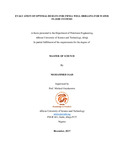| dc.description.abstract | One of the ways of maximizing recovery from a reservoir is by drilling infill wells. Infill well placement is challenging because many well scenarios must be evaluated when undertaking the optimization program and very often, the variables that affect reservoir performance are nonlinearly correlated with some degree of uncertainty. Resultantly, the use of stochastic search algorithms has gained wide acceptance in solving problems associated with well placement.
This research seeks to analyze the efficiency of the flood patterns as published by Crawford and to ascertain the efficiency of the peripheral pattern which is not available in literature. Also employed is an efficient optimization tool to solve the well placement problem by identifying the optimum locations for the infill wells. Particle Swarm Optimization Algorithm (PSA) has proved to be an effective tool in addressing well placement problems, and it was employed in this research as the main optimization algorithm. Flood pattern analysis was conducted to determine the optimum pattern for the development of the reservoir model built for this study. The first was a homogenous model used to determine the recovery efficiencies of the flood patterns, i.e., 5- spot, inverted 5-spot, 9-spot, line drive, peripheral and staged line drive. The efficiencies obtained were 78.63 %, 77.89 %, 76.53 %, 58.89 %, 77.7 % and 59.25 % respectively. These were in agreement with the efficiencies published by Crawford with a 5% error. Investigation into the effect of heterogeneity on pattern selection was studied using cumulative field oil produced, pressure maintenance ability of the patterns, time to breakthrough, optimum pore volume to be injected and the economics of the flood patterns as screening criteria. The peripheral flood pattern was selected as the optimum flood pattern, while the well placement analysis and infill drilling optimization was carried out to maximize recovery from the reservoir.
A sensitivity analysis was conducted to evaluate the impact of permeability anisotropy, injection rate and maximum number of wells to be drilled on the net present value of the reservoir. After the findings, the optimum well locations, the number of wells and the corresponding well spacing was determined.
The major contribution of this work is that a methodology for infill well placement and flood pattern selection has been developed, with the efficiency of peripheral flood pattern added to literature. This is a useful tool to support petroleum engineers in deciding how to maximize the value of their asset - the petroleum reservoir. | en_US |

